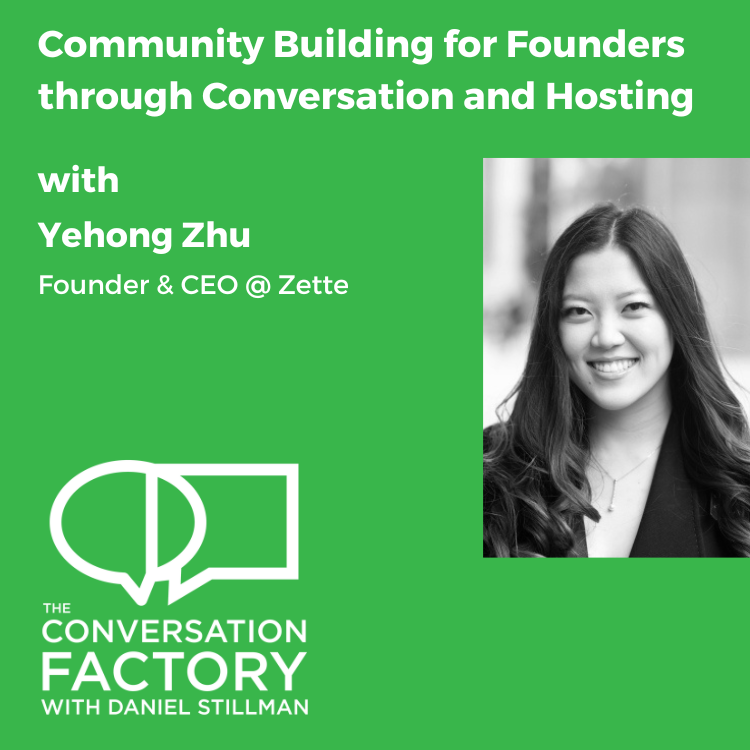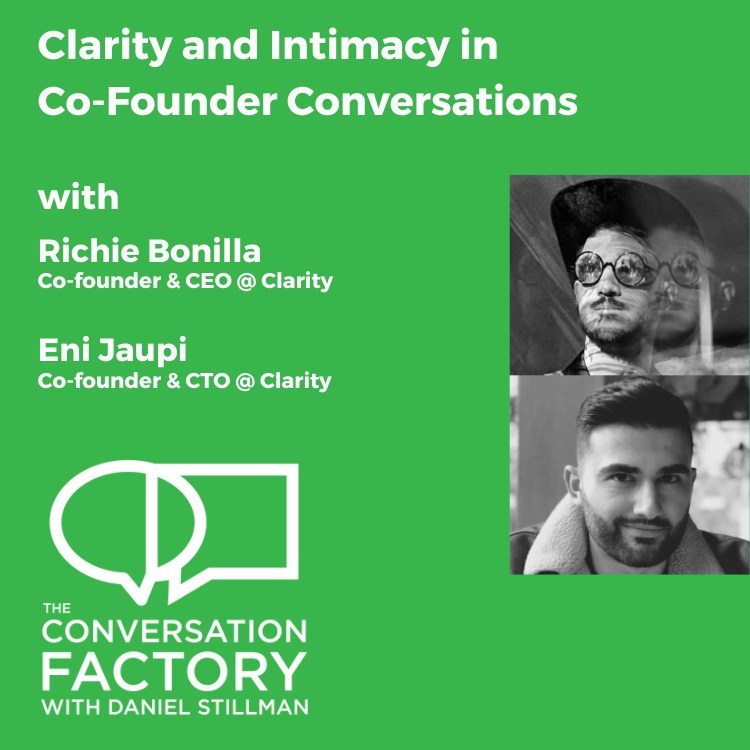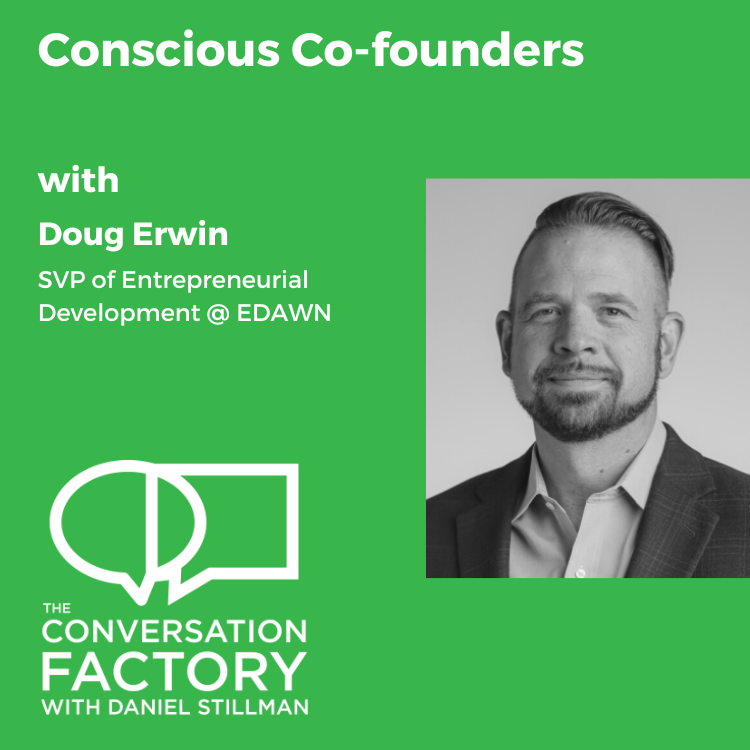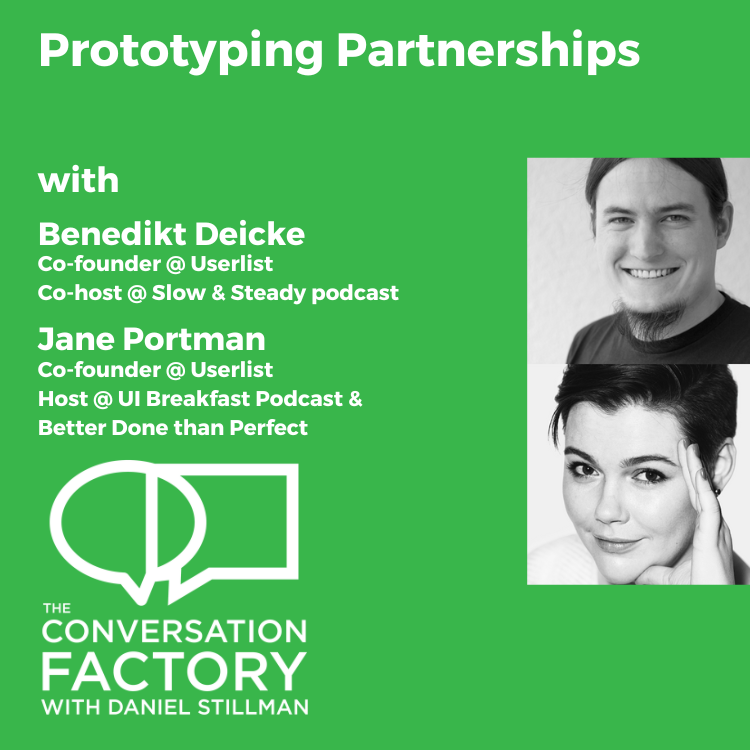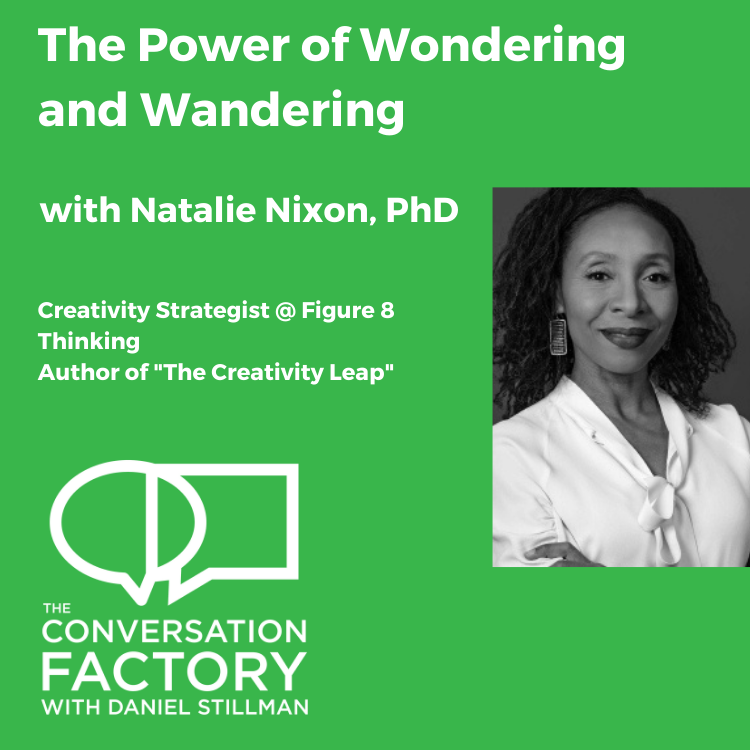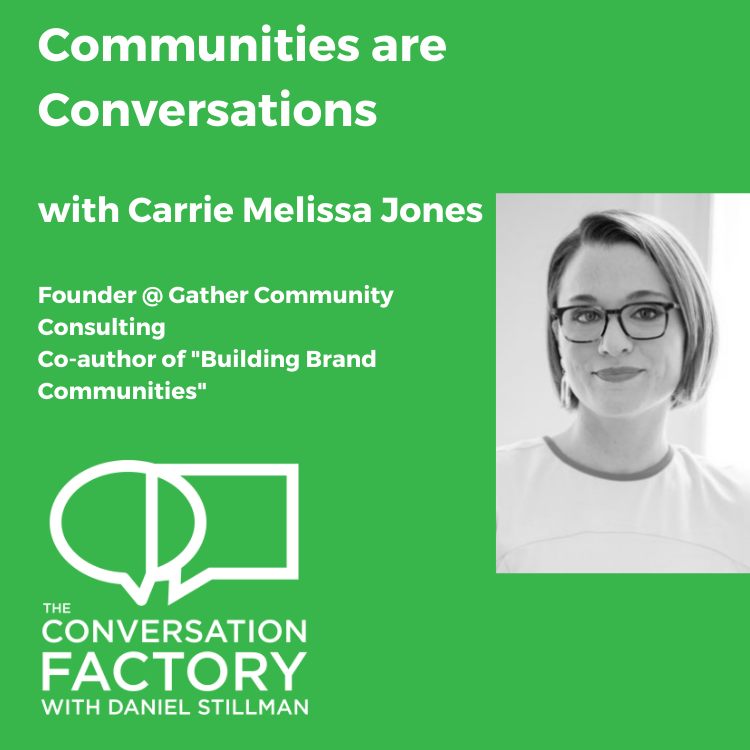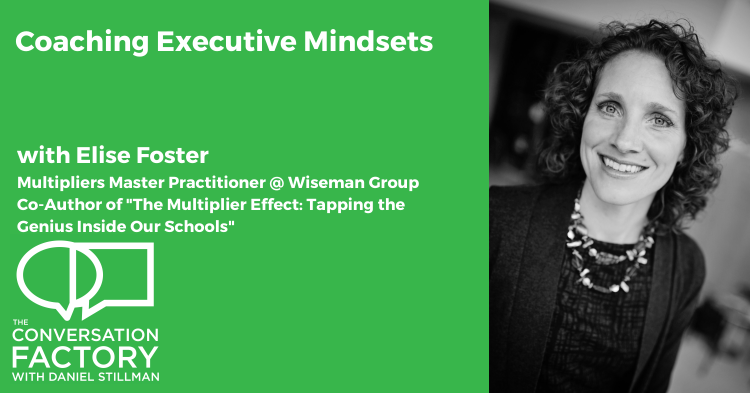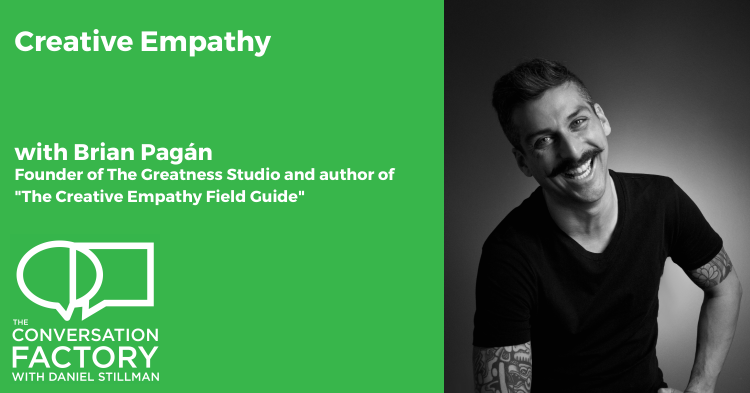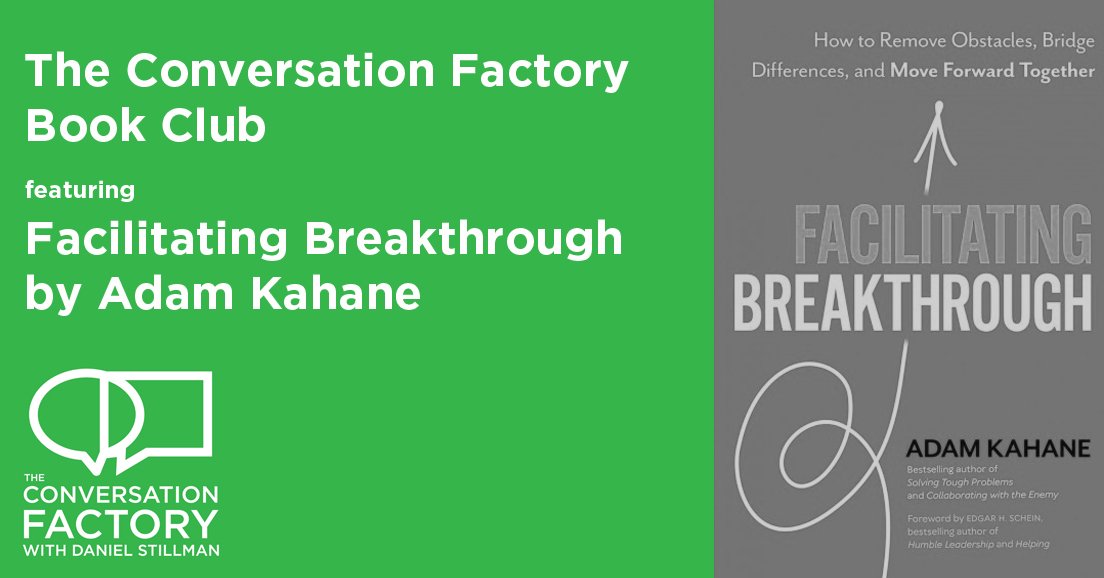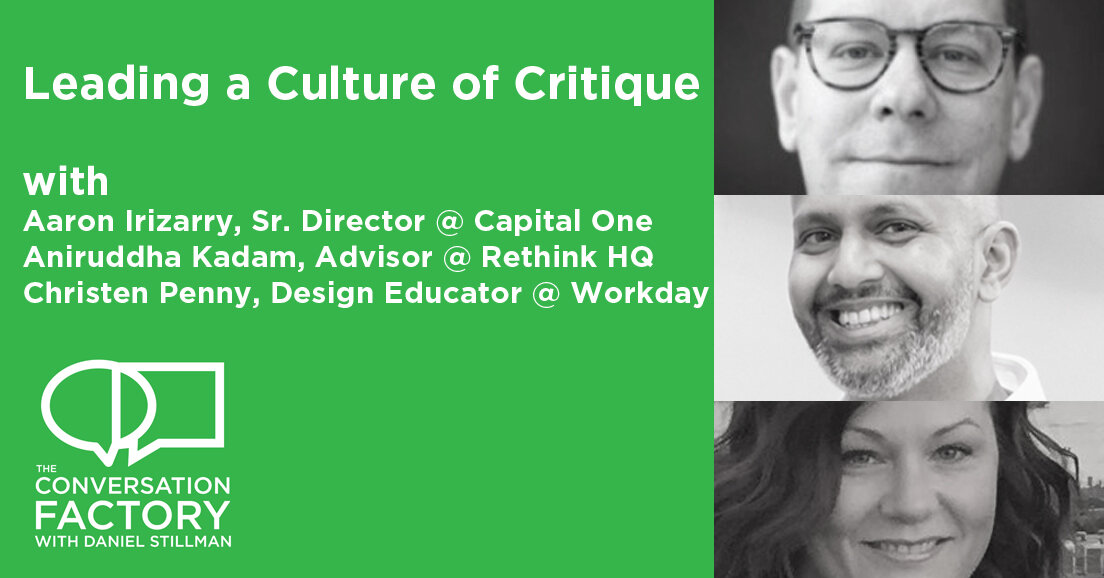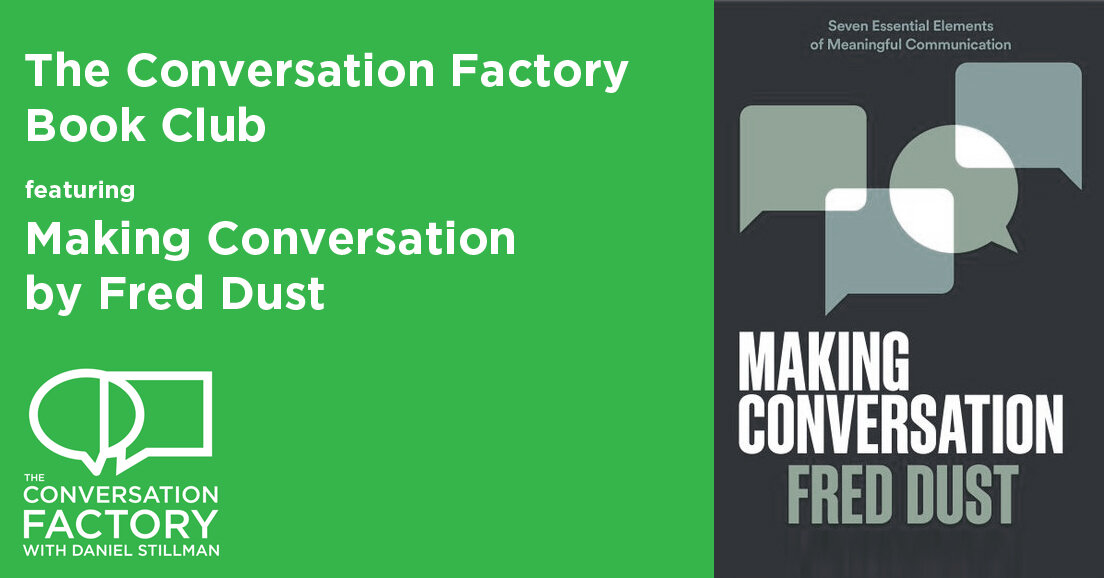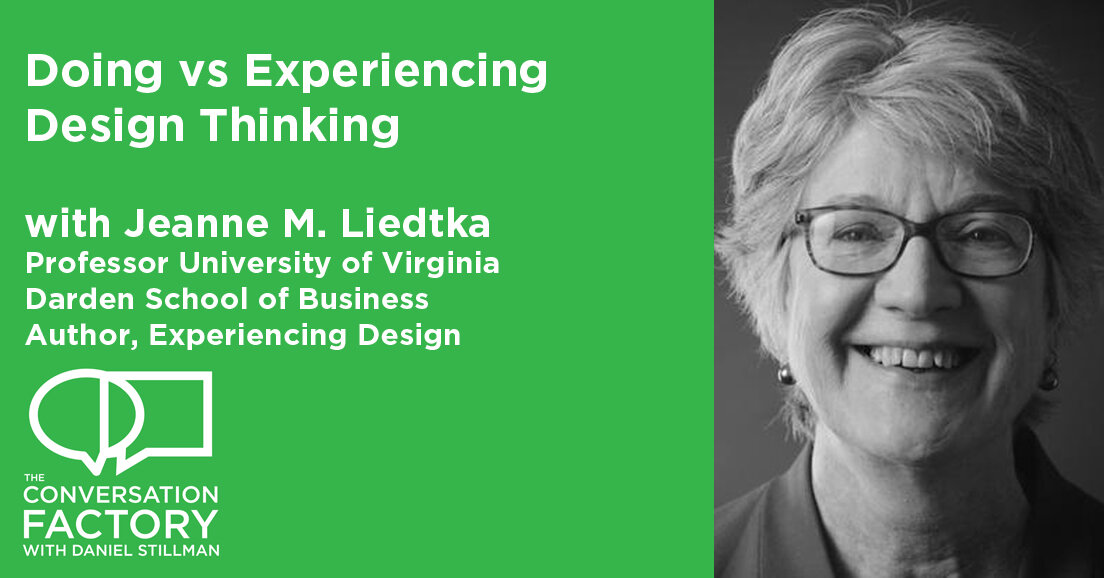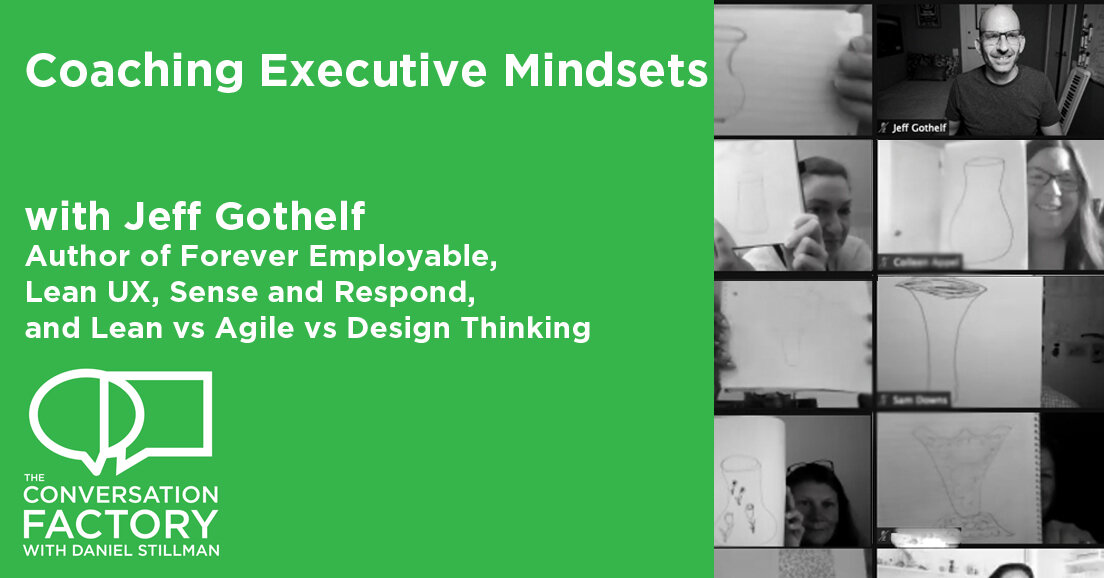Today my guest is Yehong Zhu, the founder and CEO of Zette.
We discuss three key layers of conversation design:
+ The conversation with yourself - even with so many companies founded…why not me?
+ The importance of community, community building and hosting as an integral part of staying sane, informed and productive as a founder.
+ The broader, cultural conversation - how does a founder design the conversation around why does this company matter? Shaping this narrative arc can help you connect your company’s mission to the mission of potential funders and advisors
Prior to starting Zette, she worked as a journalist at Forbes Magazine, where she reported on business, market and technology trends. She also worked as a product manager at Twitter on two consumer teams—the Tweets team in San Francisco and the Events team in London—where she shipped features on desktop, mobile web, iOS, and Android to 330M users globally. She graduated from Harvard College in 2018 with a degree in philosophy and government.
Links, Quotes, Notes, and Resources
Minute 1
Yehong Zhu:
I've always believed that there are a lot of problems in the world to be solved. I think that, why not me? Right? Why not be the one to identify some of the issues in the world and work towards solving them, even if they're not previously solved issues, doesn't mean that they're impossible to do so. And so I think that there's a lot in the world that requires vision and creativity and courage to make it better or to at least make it more palatable. Right?
Minute 16
Yehong Zhu:
as nothing that could have prepared me for what was coming next, which was that I had to figure out how to recruit an entire team remotely and build a remote culture from nothing essentially, how to figure out how to fundraise entirely over Zoom. And how to get a network of warm introductions when the city that I had supposedly moved to, because it was at the genesis of Silicon Valley was completely a ghost town at the time. And so my tactic switched from meeting investors for coffee in coffee shops to badgering them on LinkedIn. You know what I mean?
A lot of the adaptations that I was forced to go through, I think ultimately made me a stronger founder, a more flexible, adaptable person, but it was not without tremendous growing pains. I think we all went through those, we can all think back to where we were two years ago when the pandemic first hit. I think it's particularly hard when you're just starting out, because it's not like you have an existing base of resources or an existing set of colleagues or co-workers or a network that you can lean on, because you're just at the beginning of your journey.
And so there's pros and cons of course, but I think one of the pros is perhaps ironically having such a difficult beginning gives you a better sense of preparedness for what's to come after. Right? If the beginning's not a cakewalk, you know that the whole journey itself is going to take a lot more than perhaps you would've thought, but it does prepare you to be a more resilient founder.
Minute 21
Yehong Zhu:
I think that one of the interesting side effects of living with other founders is that it makes you a better founder yourself. Because anytime you have a question around let's say, what's the right business strategy to employ here, or who are the best accounting firms to work with or what do certain investors or firms do for founders versus other investors? These are difficult questions to answer in a vacuum, right? You need information that's both accurate and relevant and recent and all of these things. And the internet is so full of different pieces of information that sometimes it's hard to know what to trust.
If you're struggling with fundraising, for example, you can try to figure out from reading blogs on medium from five years ago, if you're doing the right thing, or you can ask your friend who literally just raised around two months ago, what the actual environment is like right now. And so I think some of these connections and these networks that you meet in-person when you're actually friends with someone and they're able to be honest with their experiences, can help you so much more than if you were just trying to figure it out on your own.
Minute 29
Yehong Zhu:
If you're on a mission to do something that's greater than yourself, you can get a lot of people excited by the mission you're pursuing, because perhaps it's something that's equally important, if not more important to them, a lot of people care about democracy, right? A lot of people believe that reliable information, factual information journalism is the foundation of a strong and healthy democracy.
And so they get excited by people who are working on new ideas in this space, because maybe in another life they would've wanted to work on the same idea. Maybe they even had a similar idea and they're just glad that they're meeting somebody who's actually pursuing it. Right? And so I think there are a lot of ways to establish that connection with somebody. It depends on what they care about.
More About Yehong
Yehong Zhu is the founder and CEO of Zette. Prior to starting Zette, she worked as a journalist at Forbes Magazine, where she reported on business, market and technology trends. She also worked as a product manager at Twitter on two consumer teams—the Tweets team in San Francisco and the Events team in London—where she shipped features on desktop, mobile web, iOS, and Android to 330M users globally. She graduated from Harvard College in 2018 with a degree in philosophy and government.
Full Transcript
Daniel Stillman:
Well, then I will officially welcome you to The Conversation Factory, Yehong Zhu. Thank you for making the time today, working through all of the internet troubles that assail us eternally.
Yehong Zhu:
Yes, indeed.
Daniel Stillman:
Listen, I'm really glad that Michael put us together. I'm excited to peel back the layers of the conversation that you're having with yourself around the building of your company. And I'm wondering for folks who are listening, entrepreneurship is important to you. Why is that a value of yours and what made you want to start the company that you're helming right now?
Yehong Zhu:
I've always believed that there are a lot of problems in the world to be solved. I think that, why not me? Right? Why not be the one to identify some of the issues in the world and work towards solving them, even if they're not previously solved issues, doesn't mean that they're impossible to do so. And so I think that there's a lot in the world that requires vision and creativity and courage to make it better or to at least make it more palatable. Right? In my particular sector, the industry that I happen to care about is journalism.
Yehong Zhu:
My mother was a journalist before me, and I've always found it to be an incredible art form that also informs people, educates people and gets important stories out into the world. But it was an art form that was always struggling ever since the digital age at least with its business model, in terms of getting people to pay for and subscribe to reading online news has been tricky ever since the subscription model changed from being purely a print based one to a digital based one. And paywalls are now kind of abundant and it makes it really hard to decide what you should pay for, maybe inconvenient to remember how many subscriptions you have or hard to cancel, hard to keep track.
Yehong Zhu:
And so a lot of the issues that we face in not reading the news, I think comes from our inability to even access the right information at an affordable price. And so that was the problem that I saw in the market, and ever since I was young I was pretty resourceful, pretty entrepreneurial in a sense. When I didn't see certain clubs in my high school, I wanted to go found it myself. And when I was in college I wanted to start a college admissions consulting company, which I ended up doing to help underprivileged students get into universities.
Yehong Zhu:
And so I had this pattern in my earlier life of just going for the things that I wanted. And in this particular case I started Zette during a time of tremendous misinformation and the fake news crisis that Donald Trump called it. I think that it's a really important value and journey to be on, which is why I'm excited to be an entrepreneur in this space.
Daniel Stillman:
Does Zette take a position on what news people can access? How does curation come to bear on helping people find the things that they want, to eventually subscribe to?
Yehong Zhu:
Our first level of curation is really just figuring out who the paywall properties are. There's almost a self selection process there of, typically some of the higher let's say expense productions require paywalls. So journalistic outlets that employ newsrooms of journalists tend to have a harder paywall on their content in order to fund the journalism that they use. Whereas there's a lot of blogs and content sites and maybe let's say more clickbait websites out there that don't have strong subscriber base, because maybe their content isn't something that you would consistently pay to read, but rather you would find it on the internet as a free site and you would click on it there.
Yehong Zhu:
There's, I would say, firstly, a difference between the journalism that paywalls itself versus the information that doesn't have a paywall to start. And so looking at the journalism that does have paywalls, our next step is figuring out, who would want to work with us, right? How many of these publications can we partner with at a given time? For example, we might want to target an umbrella corporation with many, many titles instead of just a single title that's privately owned, just because it allows to give the scale of reach that we would want for our audience.
Yehong Zhu:
And so that's how we start filtering down to what editorial lenses are we promoting, but it's more so from a logistical perspective rather than through let's say dogmatic perspective.
Daniel Stillman:
Sure, sure. I really loved the three virtues or values, I guess you'd really say, that you outlined of vision, creativity and courage. I'm curious when you started thinking about this challenge, as we were saying before we started recording, I feel everything starts with an internal conversation. How long were you telling yourself this is a thing that needs to exist?
Yehong Zhu:
I think I first started thinking about this problem in 2016. At that time I was a business reporter for Forbes magazine. I noticed that a lot of the articles that I was writing had a lot of advertisements attached to the articles that were being published. Right? I publish an article, there'd be seven or 10 ads on the page. I remember asking my editor at the time, why are there so many ads on the page? Doesn't it make it hard to read the actual content of this article?
Yehong Zhu:
He mentioned that because Forbes was ad based at the time, it made sense to put more and more ads on a single page, just because each ad only brought in a tiny sliver of revenue, right? Pennies on the dollar. And so as a result more ads more revenue. And so I could already see the problem then, which is that more ads or at least filling the page with ads led to not so great of a user experience. And it also didn't lead to that much money, which meant that subscription revenue was an obvious next step, not just for Forbes, but for a lot of national publications at the time.
Yehong Zhu:
But then if you assume that a lot of publications will move towards subscription revenue and paywalls, that meant that everyone would start paywalling their content. Right? And that meant that for the average user, for the average reader, it's going to put them in a tough position because no one can buy everything, right? It's not like you can justify buying subscriptions to a hundred different sites because you're probably not even going to read all of those sites on even a monthly basis.
Yehong Zhu:
It's only the occasional time when you hit a paywall, when you realize I do want to read this article, but I might not actually want a subscription. So it also puts the publishers in a tragedy of the common position where they're fighting almost against each other for the next additional subscriber. When I think if you just put let's say a pay per view model in front of the consumer, what happens then is that you can actually give them more options. Right? It's like opening up an entire economy class of an airplane that previously only sold business class. Right? As a result more people would want to fly aka more people would want to read legitimate journalism.
Yehong Zhu:
I saw the issue a long time ago, but I naturally assumed, and this is a funny thing that I think a lot of entrepreneurs might assume, that if a problem is that obvious someone is probably already doing it or somebody will do it for [inaudible 00:08:06]. Right? And so at the time I remember thinking, oh yeah, well, someone's just going to sound Netflix for news or Spotify for news startup and I'll be the first user of it when it comes out in a couple months or next year. Right?
Yehong Zhu:
The funny thing is that four years passed. And by the time I was ready to jump into entrepreneurship again and rethinking about the problems in the world, this problem had still not been solved and I was still in a state of shock that it hadn't.
Daniel Stillman:
Why do you think that is? I'm curious. Why hasn't anybody else tried to solve this?
Yehong Zhu:
Well, I think that there have been some attempts previously, but I think that timing here is a large factor. Like I mentioned before at the time that I was writing for Forbes, Forbes itself had not gone under paywall yet. Right? It was still reported. And a lot of internet based media companies were free. They were giving out content for free. They were giving out content with apps. And paywalls were starting to become a thing, but they were nowhere near as prevalent as they are now.
Yehong Zhu:
I think the other issue is that increasingly I think media companies and a lot of companies worldwide are realizing that they need to figure out how to get that elusive millennial or gen Z consumer on board. Because if you think about the media industry at least in terms of historical customers, it was usually older generations that would buy print newspapers, who would then sign up to be digital subscribers online. Right?
Daniel Stillman:
Yes.
Yehong Zhu:
But in order to keep the bloodline of your business strong, you need to make sure to appeal to newer generations of users, right? Every single year. I think what newspapers are quickly realizing is that they don't have a good strategy for capturing a digital native audience that might not even know what The Economist is. Right? They might not even have a reading habit up front. And so increasingly it's becoming more and more important to start appealing to let's say the TikTok generation or the social media generation, and really convince an entirely new demographic of users to start paying for news for the first time.
Daniel Stillman:
That's the narrative and it makes sense to me. How does that play with the people that you need to bring on board, your subscriber partners?
Yehong Zhu:
I've been speaking with a lot of media companies, a lot of media executives, and I think that there is an awareness around this exact problem, around reaching new demographics, around figuring out more sustainable business models, but there's also a hesitancy, right? Because if you can recall, technology obliterated the existing models. And so there's sometimes a little bit of hesitancy to try new technological innovations, to worry about the onboarding cost of, is this going to cost me engineering time? Is it going to cost money? Is it going to work? Right?
Yehong Zhu:
So there's a bit of hesitancy there to try bold new ideas. And there's still grappling with changes in the industry. Right? And so a lot of journalists were laid off in the past couple of years, some outlets did tremendously well, like the New York Times, while a lot of local news outlets really struggled with their own business models and retaining their audiences. There's a huge berth in terms of the problems that newsrooms are struggling with. And in addition to that, there are things like the death of the cookie. Google's getting rid of third party data, which means that a lot of the important data elements of advertising are being done away with.
Yehong Zhu:
And so there's a lot that they need to already innovate on that end. Right? In terms of data and data privacy regulations, et cetera. And then with COVID and with newsrooms scrambling to adapt to remote first environments or figuring out what to report on that's super relevant, there's a lot of movement on the editorial side as well. And then finally I would say in the macro environment, a lot of newspapers are being bought up by hedge funds, right? Or ownership is being transferred at lightning speed right now. And so there's a lot of management changes on top of all the other changes that are going on in the industry.
Yehong Zhu:
It's not super straightforward for them to see, hey, we need to shift everything to this new model right now. But I think with time there's going to be increasing recognition that innovation needs to happen and it needs to happen sooner rather than later.
Daniel Stillman:
It's interesting when we were talking, when I did my interview with our mutual friend, Michael, we talked about these three levels of conversation, these concentric circles. I think he thought of it as an onion. And there is that self conversation. We manage ourselves and we coach ourselves and then there's conversations with others, didactic, multiple team conversations, and then further and further out there's conversations with community and culture. What I'm hearing as you're talking about some of the challenges with Zette is, some of these bigger conversations where there's a lot of chaos or uncertainty at the macro level.
Daniel Stillman:
But I'm also curious as you're building this company, what's going on at the you level and also at the team level? I know that you were saying you're a solo founder, but nobody builds anything 100% by themselves. What you talked about in our pre-conversation, talking about trials and tribulations. I'm curious, there's definitely some turbulence at that macro level and I'm wondering what's going on at the micro and the meso level trials and tribulations with building this company?
Yehong Zhu:
I think that there have been a tremendous amount of obstacles and adversity when I was first starting to build Zette. And even now I think that the obstacles don't go away, they just change in form and function. In the beginning I remember I was so optimistic about starting a company, this was in February, 2020, right? Where we were the top of a-
Daniel Stillman:
That's just the punchline, way too many, there's so many stories that start. It was February 2020. Oh boy.
Yehong Zhu:
Imagine how I felt starting a month later. But I was freshly off of quitting my job at Twitter, where I used to be a product manager. I was full of this naive optimism about this startup being the greatest thing and I would move back to San Francisco so I could recruit engineers in-person. And I would attend these media conferences to get to know people. So I had booked all of these flights in advance. On a personal level I was in a long term relationship. So I knew I needed that stability on the personal front to take a huge professional risk.
Yehong Zhu:
And in a sense all of that came crumbling down, because San Francisco was one of the first cities in America to go through a complete lockdown. Right? And so within barely a month of starting to research about the company and figuring out the industry dynamics and starting some of those recruiting conversations, the whole world just flipped upside down on its head and all the playbooks that I had read on how to raise money and how to recruit people, of course were written for pre COVID world.
Yehong Zhu:
And so there was nothing that could have prepared me for what was coming next, which was that I had to figure out how to recruit an entire team remotely and build a remote culture from nothing essentially, how to figure out how to fundraise entirely over Zoom. And how to get a network of warm introductions when the city that I had supposedly moved to, because it was at the genesis of Silicon Valley was completely a ghost town at the time. And so my tactic switched from meeting investors for coffee in coffee shops to badgering them on LinkedIn. You know what I mean?
Yehong Zhu:
A lot of the adaptations that I was forced to go through, I think ultimately made me a stronger founder, a more flexible, adaptable person, but it was not without tremendous growing pains. I think we all went through those, we can all think back to where we were two years ago when the pandemic first hit. I think it's particularly hard when you're just starting out, because it's not like you have an existing base of resources or an existing set of colleagues or co-workers or a network that you can lean on, because you're just at the beginning of your journey.
Yehong Zhu:
And so there's pros and cons of course, but I think one of the pros is perhaps ironically having such a difficult beginning gives you a better sense of preparedness for what's to come after. Right? If the beginning's not a cake walk, you know that the whole journey itself is going to take a lot more than perhaps you would've thought, but it does prepare you to be a more resilient founder. And if you can start a company during a pandemic, you can probably do anything. That's my sense.
Daniel Stillman:
Yeah. Well, let's talk about what that process was like, badgering VCs on LinkedIn doesn't sound like that much fun. Was it effective?
Yehong Zhu:
I think it depends on how you go about it. There's definitely methods to the madness. I think that I learned a lot about the value of form introductions and going through people that I had previously known or worked for. I also tried to make new friends and new connections through unconventional means. For example, I wrote an article about what it was like to start a company during COVID and it went viral. And through that virality, I was able to be connected with other founders and investors who read my work and resonated with what I was building.
Yehong Zhu:
And so that's a way that you can make connections at scale rather than going one by one. And then I would join these other communities that were relevant to me. So for example, I would find networks of female founders, and then I would sign up for these mentorship calls or these listicles where everybody who wanted to connect with other founders would write down their names and put down their social media. And so I would go through one by one and reach out and just ask for a call or ask for a conversation or some advice.
Yehong Zhu:
And I found that, not all these conversations were helpful, but for the ones who were helpful, I ended up making very close friends with other founders who were also struggling to find community, who were also struggling to find their bearings. And then eventually I moved from the online world to the offline world. So having met a lot of interesting, cool people through different means online, I started some founder group houses where I would actually live and work with these founders in different cities.
Yehong Zhu:
I started a female founder house in Maui, and then another one in Mexico. And through these networks I was able to actually start meeting new friends and colleagues in-person, as opposed to only being in the basement of whatever apartment I was renting in San Francisco.
Daniel Stillman:
What I'm hearing you say, these are such universal challenges of how to go from a cool introduction to a warm introduction. And one of the things I'm hearing you say is, start with warm introductions. There's a lot of strength in warm introductions. The other thing that I'm hearing you say, which I agree with wholeheartedly, is that, creating your own opportunities to connect with people at various levels of scale is important.
Daniel Stillman:
As you said, like communities, but also on the smaller scale, these houses where there's not just communities that are diffuse and on the internet, but grounded in a place and a space and being the host of those communities is a really, really powerful approach to building deeper connection.
Yehong Zhu:
Yeah, definitely. Because as much as we can build community online, we are physical creatures that exist in physical spaces. And I think the great tragedy of social distancing is that it's exactly that you're distanced from the social connections and warmth that you need, right? To live on, to build cultures, to build community with. And so as much as the world is now remote, I think that there is an imperative value of being in-person or at least of having the in-person connection with your team, with your family, with your friends, with your colleagues, that you should strive to maintain even as the world is crumbling around you, because that is the thing will keep you sane.
Daniel Stillman:
I'm curious, did these group houses in this community building effort, what's the narrative you tell yourself about the signs and signals you're seeing that it is effective? Because I think there's on one level it's just as you said, it keeps you sane and human connection is just purely essential. But then there's the flip side which is, is it giving you business results that you're looking for?
Yehong Zhu:
I think that one of the interesting side effects of living with other founders is that it makes you a better founder yourself. Because anytime you have a question around let's say, what's the right business strategy to employ here, or who are the best accounting firms to work with or what do certain investors or firms do for founders versus other investors? These are difficult questions to answer in a vacuum, right? You need information that's both accurate and relevant and recent and all of these things. And the internet is so full of different pieces of information that sometimes it's hard to know what to trust.
Yehong Zhu:
If you're struggling with fundraising, for example, you can try to figure out from reading blogs on medium from five years ago, if you're doing the right thing, or you can ask your friend who literally just raised around two months ago, what the actual environment is like right now. And so I think some of these connections and these networks that you meet in-person when you're actually friends with someone and they're able to be honest with their experiences, can help you so much more than if you were just trying to figure it out on your own.
Daniel Stillman:
I think this is so true and so important, and it's a very powerful way to resource yourself. I think my pushback is, creating community with your peers is essential. But the question that I'm sitting with is, you were talking about badgering VCs on LinkedIn, that doesn't seem, I'm guessing that wasn't a super effective strategy. Community building and networking with people outside of our peers or near peers or affinity groups is really challenging.
Daniel Stillman:
I'm curious what you found has been helpful, because you're talking about connecting with people like engineering resources, accounting resources, fundraising. How have you found building your network with those groups that are not your direct peers has worked for you?
Yehong Zhu:
It's a good question. And just a quick caveat, it is surprisingly more effective than you think to badger VCs on LinkedIn because their job is to talk to peers.
Daniel Stillman:
Fair.
Yehong Zhu:
I think depending on why you're badgering them and what the messaging is around speaking with them, they're actually very receptive to taking conversations because that's what they're getting paid for. Right? Their job is to introduce deal flow into their firms. That's just a quick side note. It's an excellent question. I think that there's, when I was at Twitter I learned that there's three types of management. You have to manage up, you have to manage down and then you have to manage around you. Right?
Yehong Zhu:
So comfort talking with superiors and decision makers, comfort talking to the people that you're working with on your team who are more junior than you, maybe even mentoring the folks who are more junior and then comfort with your own peer group, right? And the folks, your equals. I think all three are critically important to your success, because at the end of the day they're all going to be part of who you are as a leader and as a manager.
Yehong Zhu:
And in terms of how that functions, I think on a founder level, your team, right? Is going to be the folks that you work with and work together with and collaborate with and figure out, okay, how do we actually move this enormous problem forward? Whereas other founders from different teams, different industries, they're more of your contemporaries, your peer group, right? That's the folks that you are at a similar stage with, that you can learn from and with and together.
Yehong Zhu:
And then the folks who are ahead of you, or maybe in positions of influence, but maybe tangential to what you do, for example, investors or later stage founders who maybe are in your same industry or in your same vertical, or perhaps can act as mentors, are also extremely important folks to know, to have in your network. And in terms of how you meet them, I think there's a variety of ways, warm intros, cold outreach, going to events and speaking to the speakers afterwards, getting connected to people that you know, asking investors who have invested in you to open up their rolodexes to introduce you to the right folks.
Yehong Zhu:
I think these are all targeted strategic ways to develop a relationship or at least get that first meeting. And then in terms of how you actually develop a relationship, I think to some extent it has to happen organically, right? People are really busy, especially important people, right? And so they're not going to have time to mentor everybody that they need or take every meeting that is asked of them. And so making sure that you explain your relevance or what that relationship is going to get for both of you is often a good sign.
Yehong Zhu:
So for example, if you're starting an advisory board and you want to hire someone as a potential advisor, that could be a beneficial relationship for both sides, both someone looking to be on a board and for you yourself looking for expertise at a higher level. And so I think that's a little bit of, from my experience, building connections with folks that I'm not directly in touch with, but of course there's so much more that I could learn, more from other founders and entrepreneurs who can do this a lot better.
Daniel Stillman:
This is really, what this is bringing up for me is, there's this systemic approach to as you said, diversifying the nodes in your network strategically. Right? So being cognizant, it sounds like you were very intentional about building out as you said the up, down and around components of your network. And it seems like there's still this need at the conversational, the conversation by conversation level to be fully present and the ability to actually connect and invite someone into a deeper conversation.
Daniel Stillman:
There's no substitute for, it's like you've caught the fish, the fish is on the line and now what do you do? Right? And so I'm curious, A, if that resonates for you, and B how you feel you in the moment, in the conversation create that affinity and that desire for them to really go a little bit deeper with you.
Yehong Zhu:
It's a great question. I think that for me, a lot of the times it depends on how you communicate your mission, right? If you're on a mission to do something that's greater than yourself, you can get a lot of people excited by the mission you're pursuing, because perhaps it's something that's equally important, if not more important to them, a lot of people care about democracy, right? A lot of people believe that reliable information, factual information journalism is the foundation of a strong and healthy democracy.
Yehong Zhu:
And so they get excited by people who are working on new ideas in this space, because maybe in another life they would've wanted to work on the same idea. Maybe they even had a similar idea and they're just glad that they're meeting somebody who's actually pursuing it. Right? And so I think there are a lot of ways to establish that connection with somebody. It depends on what they care about. Sometimes in my case, if there's affinity around being a female founder, being an Asian founder, right? Or being a founder who's a solo founder, building a remote team, there's all sorts of ways that you can connect with other entrepreneurs, other investors, other people who will help you on your journey.
Yehong Zhu:
And just finding where your relationship overlaps, the similarities that you can connect to often strengthens that bond. For example, I think alumni networks are a good example of this, where no matter what school you went to, there's probably some really impressive alumni from your university. And if you reach out on a basis of that alumni connection, there's always that connection that you can lean back on. Right? And of course that's only going to open the door for you if they are receptive to that. But after that when they get to know you a little bit more, I think that there's different ways that you can connect further based off of that.
Daniel Stillman:
It's interesting, in a way I'm going back to looking at my visual notes, the seed of entrepreneurship for you is vision, creativity and courage. And it seems like the foundation of being able to connect with someone else can stem from as you say, communicating your mission, but also connecting to their purpose.
Yehong Zhu:
Yup. Definitely.
Daniel Stillman:
I don't think there's any substitute for, as you say, empathy and curiosity for the person on the other side connecting your mission to their mission and their purpose.
Yehong Zhu:
Agreed. I think that connection is so important because you have to ask yourself like, why do we wake up every morning? Right? What is it that we want to do with our lives? Or what is it that we want to do in the world? And I often hear that talking to founders is very inspiring, because these are the people crazy enough to think that they can change a seemingly impossible or immovable problem. Right? That's so big that it feels bigger than ourselves, that it feels like maybe this is just how the world has always been and always will be.
Yehong Zhu:
But I tend to see the world as a changeable thing. Right? The universe is not fixed. It's moveable. It might take a lot of time and effort and money to move some parts of it, but that doesn't mean that every single part of the world wasn't just built by people like us. Right? And can't be [inaudible 00:32:33] to be better and stronger and faster. Right? And so I think maybe that fundamental philosophy is what differentiates founders from everybody else.
Daniel Stillman:
Yeah. I'm always cautious about quoting Steve Jobs because, let's admit it, he was a bit of a jerk. But he did point out and I think rightly so that everything in the world was made by someone. Right? In one sense everything around us is natural and another sense everything is, because we're natural in some sense, but we have created all the systems around us and the people who came before us were just like us, which means we can make new systems if we choose to. There is that reality distortion field, that infamous reality distortion field around Mr. Jobs that made this possible.
Daniel Stillman:
I guess I'm curious, going way back towards the beginning of our conversation, you talked about that enthusiasm and that energy. I feel with every creative conversation, there's energy at the beginning and there's a dip somewhere in the middle. I'm curious, did you experience a dip and how did you pull yourself through your dip?
Yehong Zhu:
Are you talking about a dip in stamina through the startup journey?
Daniel Stillman:
Yeah. When I think about the startup journey, there are, I imagine many dips, from fundraising dips to team building dips, to dips in your own faith, in that reality distortion.
Yehong Zhu:
For sure. I think there's always going to be setbacks and disappointments and people telling you no or people telling you that it's not possible. But I think that what keeps you going, or at least what keeps me going is the sense that this is such an obvious solution, is that if you can just get to market, everything will work. And maybe that's not necessarily true, but it becomes a self-fulfilling prophecy. Right? You start reframing dips as clearing the way for people who are your supporters to find you, right?
Yehong Zhu:
It's almost like if fundraising or hiring even is a numbers game and every 10 people you approach will say no, but that means that one out of the 11 or 10 will say yes, then every no becomes a celebration because you just cleared the way for someone who wouldn't support you anyway, to getting closer to finding somebody who would. I think that mindset is really, really important. And it's gotten me out of more than just a few dips, let's say. Because it ended up coming true.
Yehong Zhu:
I think that after a while, when you stop taking rejection so personally, and when you accept the fact that you're not a multimillion dollar corporation or multi-billion dollar corporation with infinite resources at your fingertips, it's going to be hard to figure out how to do the same things on a faster timeline. But if you're nimble, if you're quick, if you can pick yourself up and dust yourself off faster than your competitors, there's nothing stopping you from just keeping, making progress and continuing to rise.
Daniel Stillman:
I appreciate that. I think that's true. And it's also hard to coach yourself through those dips. Right? Because while it is true that every no gets you closer to the law of large numbers through to the yes. In that moment it can be really just authentically sad to get the no that you were hoping for a yes.
Yehong Zhu:
It's true. I think that there have been many times when I've doubted after getting the 10th no or something like that. Like, wow, is this really an idea worth pursuing? Is my vision really an actually good one to do? Is this is something that I've just made some horrible miscalculation on? But I think the beauty comes because you're never, if you just try, if you honestly try and give it your absolute best shot, it's very rare that you only ever get negative feedback.
Yehong Zhu:
Sometimes it happens because you get unlucky. Sometimes you'll flip a coin 10 times and get 10 tails. Right? Sometimes that just happens, but it's just rare that you're not going to get a single glimmer of positive feedback or hope or somebody helping you or somebody saying, hey, don't worry about that, that's usually how the process works. Let me introduce to somebody else. Right?
Yehong Zhu:
And so I think the intermittent reinforcement of getting that occasional head every few misses and then getting better at tossing a coin, I think that's what really differentiate entrepreneurs who are able to go the distance. They see every sliver of hope as a triumph. And so that's the thing that keeps them going for the next triumph and the next one and the next one after that.
Daniel Stillman:
I think that's really beautiful. It's also clear, going back to the importance of having a community of peers, because when, and I've certainly found this in my own experience, when my own inner coaching fails, right? There's my peers to absorb some of the negative feelings and also to provide positive encouragement, that community is invaluable in those moments of those dips.
Yehong Zhu:
Yeah, definitely. I would say your community is valuable. Your team is just as valuable if not more, because your team, these are the people that chose to give their time, give their energy, give their lives to work on the same mission that drives you, right? Because they resonate with it, because they believe in it and they'll be there for you on the days where you think, oh my gosh, this is the worst day of my life, right? So you can go back to your team and remind yourself why you're doing this and why they're doing this and then move forward together.
Yehong Zhu:
And at the end of the day you only really need one person to believe in you. And fortunately that one person can be yourself, right? If you just have somebody believing that it's going to work out, that's all you need to take yourself up again and then keep going the next day.
Daniel Stillman:
Right. It's one person at one time. So at one moment it could be you and at another moment it can be your mom and in another moment it can be your coach, and another moment it can be your friend.
Yehong Zhu:
Exactly.
Daniel Stillman:
It's just like, I'm envisioning a relay race of reality distortion, that as long as somebody is willing to keep the energy going, we'll keep moving.
Yehong Zhu:
Keep the faith.
Daniel Stillman:
Keep the faith and keep it moving forward.
Yehong Zhu:
Definitely.
Daniel Stillman:
Listen, we're getting close to the end of our time here. I really appreciate us getting to this point in the conversation. What haven't I asked you about that I should be asking you about when it comes to the entrepreneurship journey, and as you say, overcoming managing, writing the wave of these trials and tribulations on the entrepreneurship journey?
Yehong Zhu:
I would say that it's important to ask about your why. I remember I spoke to Biz Stone once, he's one of the co-founders of Twitter, and he told me that everything takes 10 years. Every overnight success you see, it's not really overnight, right? You've got to be able to be in the trenches for 10 years in order to really see the fruits of your labor blossom into something that you would've never previously thought possible. And so you've got to have a really strong why for why you're doing this thing that you're doing and why you're going to be able to go the distance.
Yehong Zhu:
You've got to assume that on the worst days that you have when you're being beaten down by the entire world, why are you going to get back up again? What's that thing that's driving you towards it, or are you even going to get back up? Right? And it's not an easy job, right? If you wanted an easy job you would work as literally anything else besides being a startup founder. Right? And so understanding that upfront and knowing that's the cost of what this journey requires, I think is the most fundamental first step.
Yehong Zhu:
And if you're not willing to pay that price, and if you don't have a strong why, I would not encourage you to start a company. I would say, do something else, do anything else, and don't get into the arena until you're sure that this is the thing that you want to pursue.
Daniel Stillman:
This has really come up at a lot of different aspects. You mentioned vision very early on and the ability to connect with other people outside of your network through communicating your mission. This example with Biz Stone is so interesting. The importance of knowing your why to keep yourself going is really, really profound and very, very helpful, I think for anybody listening.
Yehong Zhu:
Thank you.
Daniel Stillman:
The every overnight success takes 10 years, people really, really forget this. The example I always cite. I remember this is going back a long time. One of my first jobs out of design school was working as a researcher and a strategist in the consumer electronics world. People would come in and they wanted to be the iPod. This is how long ago it was, Yehong. They were like, we want to be the iPod of blank. It's like they were printers, they were a dishwasher company, whatever it was. They were like, we want to be the iPod of blank. Because the iPod was the cash cow of Apple back then.
Daniel Stillman:
This was literally the cusp of the iPhone. I dug up this chart and I'm clearly going to have to dig it up again, that showed the iPod sales year on year. This is exactly what I said to them. I was like, you'd like to be a 10 year overnight success? Because the iPod was not immediately successful. When it first came out people were like, this is useless. It doesn't do half the things that the other MP3 players do, and it doesn't even have iTunes. All of the things in iPod was that made it a blockbuster took years and years and years to do. They plugged away at it for ages and nobody cared in the beginning.
Yehong Zhu:
Yep, definitely.
Daniel Stillman:
I think it's a great reminder. Biz Stone is 100% right, that we really should all be taking a long view and making sure we're anchoring ourselves to our why, and not just our why, but our vision and our mission. Right? Those are all part of the same flavor, but I feel they are slightly different flavors of one thing, which is having a core.
Yehong Zhu:
Definitely. You need to build up your foundation. Because I think the reason why why is a harder answer than how, is because there's an answer for every how, right? You can figure out how to incorporate a company. You can figure out how to hire a marketer. You can figure out how to get the right statistics that you're tracking for your analytics. All of these hows are actually already answered questions, and every big unanswered how is just a series of smaller answers.
Yehong Zhu:
But the why is something that only you can know, right? The reason behind why you would try such a crazy thing is so personal. Right? And that's the thing that actually drives everything else. And so if you can answer that, I think everything else can follow much more easily.
Daniel Stillman:
I think you're in very good company with that sentiment, by the way. Viktor Frankl quotes anicca when he says, and we have to forgive Viktor Frankl because anicca I guess really at the time, because they like many quotes, famous quotes, they just say a man. They meant, I presume I hope they meant all people. We could retranslate and say a person with a why can endure anyhow. The deeper connection we have to our core purpose we're willing to find anyhow, the how that we can find, and we're willing to endure even a difficult how.
Yehong Zhu:
Agreed. I think that quote is so on point and so important to remember, especially in these pandemic times, right? Where sometimes it feels like the whole world is crashing around us. I think it's important to realize that this too will pass. Right? But you need to have a strong core of what you're holding onto in order to survive the most turbulent storms.
Daniel Stillman:
I concur. Yehong, where should people go on the internet to learn more about you and your company, if we can direct them to other places?
Yehong Zhu:
Zette.com. That's zette.com, or they can just Google our name. Fortunately we have some pretty good SEO and hopefully our social media will pop up as well.
Daniel Stillman:
Awesome. That's really helpful. Your mission of letting people find and connect to the things that they really want to read and to create a sustainable financial model for it is a really, really awesome one. I'm grateful for you taking the time to unpack these layers of conversation in your work and life.
Yehong Zhu:
Thank you. Thank you for having me on. I think that you're asking exactly the right questions and I hope that some of our listeners will find this conversation helpful as well.
Daniel Stillman:
Thank you very much. We'll call a scene.
